The goal of this project is to determine if small-scale removal of invasive, hybrid cattails can improve abundance and diversity of plants and fish on Minnesota lakeshores.
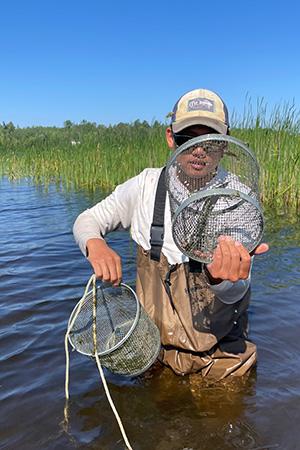
Native broadleaf cattail evolved to co-exist with other native plants, but invasive, hybrid cattails can replace diverse native nearshore plants that are important habitat for fish and fish food. A hybrid cattail-dominated shoreline can result in a lake with fewer fish (not good for anglers), reduced diversity of fish species, and a not-so-healthy nearshore ecosystem.
The scientists and students on this project are removing hybrid (Typha x glauca) cattails from sites in nine lakes across Minnesota. Hybrid cattails have expanded their range and altered Minnesota lakeshores.
The research team will compare plant and fish abundance (e.g., minnows, pictured here, and other small fishes) and diversity at sites where cattails were retained.
The project team notes that cattail removal is not appropriate in every environment.
+
What is a cattail?
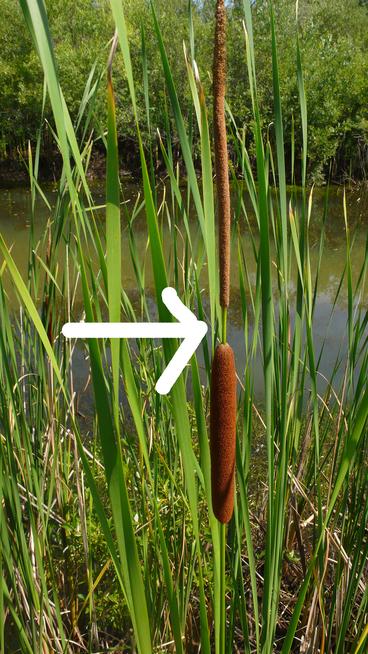
Cattails are tall, reedy marsh plants found mainly in temperate and cold regions of the Northern and Southern hemisphere. Cattails live in fresh to slightly brackish water and are considered aquatic or semi-aquatic. They are important to wildlife and some species are cultivated ornamentally as pond plants. These tall upright plants emerge from creeping roots called rhizomes. Each stalk contains male flowers at the top and female flowers just below. The long, flat leaves of the broadleaf cattail (Typha latifolia) are used for making mats and chair seats.
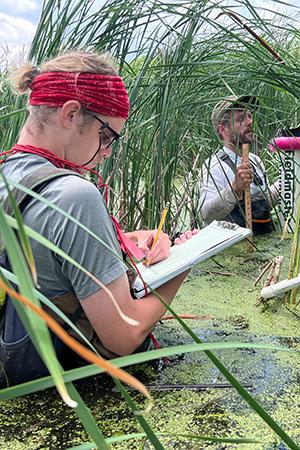
Cattail acts as an ecosystem "engineer" by outcompeting other nearshore plant communities and eventually creating an environment dominated by tall, dense, difficult-to-penetrate cattail and its litter (dead cattail).
Hybrid cattails can be hard to identify in the field. To start, observe the "gap" (identified by the white arrow in the image) between the upper male part of a cattail and the lower female part (which looks like a hotdog on a stick). If there's a noticeable gap - you likely are looking at either a hybrid cattail, or the non-indigenous narrowleaf cattail (Typha angustifolia). Our native, broadleaf cattail will have no gap between the male and female part of the plant. It is important to note that occasionally some stems of hybrid cattail will have no gap between these parts of the plant; it is important to look at multiple stems to determine what type of cattail you have.
More information about cattails:
- Minnesota Department of Natural Resources cattail species profile.
- Minnesota Public Radio News. Voyageurs National Park cattail removal project story. August 2, 2021.
- Voyageurs Conservancy, a nonprofit partner of Voyageurs National Park, story on invasive hybrid cattails. February 2021.
+
Project description
This project will fill a critical information gap by contributing to an understanding of the effects of cattail removal on littoral zone (nearshore lake zone) plant and fish communities in Minnesota's inland lakes and account for the possibility of regional differences in these effects. The study will provide ecological data on current (2021) cattail management strategies. It will also inform resource managers about the benefits and costs of localized cattail removal on Minnesota lakeshores. One of the problems with cattail is that it can eliminate the combination of floating, submerged, and emergent plants that are beneficial for fishes.
Objectives:
- Understanding the currently little-known effects of hybrid and narrowleaf cattail on the ecological dynamics of nearshore lake communities across Minnesota.
- Determining if small-scale cattail removal can increase the diversity of plant species, diversity of plant physical forms, and positively affect fish abundance and diversity.
- Comparing the effects of cattail removal on nearshore lake ecosystems in different regions of Minnesota.
The project team plans to investigate nine paired lake sites in which each site pair will have one site with cattails removed and one site with cattails retained.
The nine lake sites were selected from across three Minnesota ecoregions that all have encroaching hybrid and narrowleaf cattail. Cattail-retained and cattail-removed sites will be compared by measuring environmental variables such as plant and fish community metrics before and after cattail removal treatments. These before and after outcomes will help the scientists and students determine if cattail removal positively or negatively affects environmental variables and plant and fish communities and how this effect varies regionally in Minnesota.
Background:
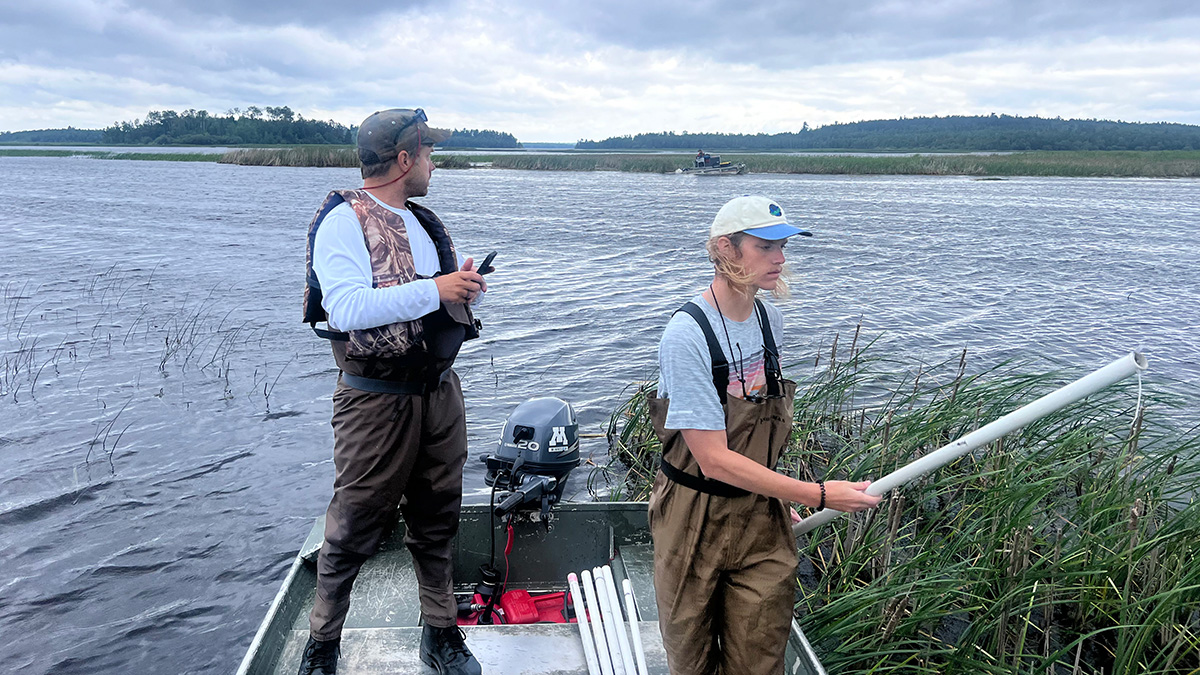
Lake littoral zone vegetation is critical for fish species as it provides spawning areas for adults (e.g., bass, pike, sunfish, etc.), nursery areas for larvae and juveniles, cover from predators, and habitat for macroinvertebrate food sources (Hall and Werner 1977, Conrow et al. 1990, Hanson et al. 2015). Many important forage fishes (e.g., minnows, logperch, darters, etc.) depend on these nearshore, vegetated habitats throughout their lives and whole-lake studies show that vegetation can predict fish presence (Randall et al. 1996, Brazner and Beals 1997, Midwood and Chow-Fraser 2012). However, it is not only the presence of vegetation that is important for fishes. As the structural complexity of aquatic macrophyte communities increases, with a mix of floating, emergent, and submerged plant types, fish tend to be more abundant and diverse, providing ecological and angler benefits (Tonn and Magnuson 1982, Conrow et al. 1990, Höök et al. 2001, Henning et al. Farrell 2014).
In Minnesota lake littoral zones, hybrid (Typha x glauca) and narrowleaf (Typha angustifolia) cattail have expanded, altering environmental conditions and displacing other plant species. Cattails replace diverse wetland and aquatic plant communities with a more homogenous environment dominated by tall, dense, difficult-to-penetrate cattail and its litter (dead cattail). This homogenization or sameness of plant communities leads to sameness of habitat and detrimental effects on other animals, including fish. Dense cattail communities reduce fish foraging efficiency, reduce their growth, and reduce their habitat. They even affect a fish's ability to breath because oxygen tends to be reduced in cattail stands.
Narrowleaf cattail is ubiquitous and readily crosses with native broadleaf cattail to produce an aggressive hybrid. This makes prevention, early detection, and eradication not feasible management objectives. However, localized cattail control and suppression can help and are key components of an asset protection approach that prioritizes conservation of important habitats.
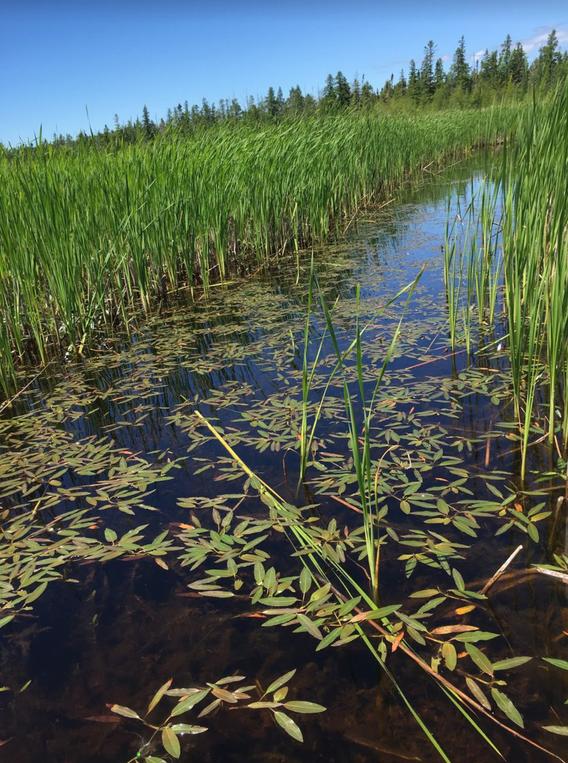
Studies have shown that when cattail is mechanically harvested, plant diversity increases, especially in younger cattail stands where intact seed banks are still in place. Similarly, excavation of channels (see image at left) through areas of dense aquatic vegetation has shown promise as a method to increase fish diversity. Fragmenting dense plant stands increases edge habitat that fish often prefer, allows increased oxygen from open water areas into oxygen-depleted littoral zones, and provides opportunity for native plant regrowth. For these reasons, localized cattail suppression has been suggested as a strategy to support plant diversity and fish communities, including gamefish that depend on littoral production of forage fish.
Despite the negative impacts of dense cattail and the potential benefits of its removal in many habitats, in some inland lakes, cattail removal could be ecologically detrimental. For example, in southern Minnesota lakes where other plant species have been lost and the native seed bank depleted due to intensive agriculture and other disturbances, cattails provide vegetated habitat and shoreline stabilization that may not be replaced by other plants coming in where cattail has been removed.
The potential costs and benefits of cattail removal are likely to be context-dependent and in Minnesota to vary by ecoregion based on differences in overall levels of environmental disturbance and capacity for regrowth of non-cattail macrophytes (i.e., more intact aquatic plant communities are found in the Northern Lakes and Forests and North Central Hardwood Forests ecoregions than in the Western Corn Belt Plains ecoregions; Bajer et al. 2016, Larkin et al. In press, Fig. 1). Thus we propose testing the ecological effects of fragmenting (adding a channel to) dense cattail stands through field experiments that are replicated in the three major ecoregions of Minnesota to provide a more robust scientific foundation for guiding cattail management.
Project activities:
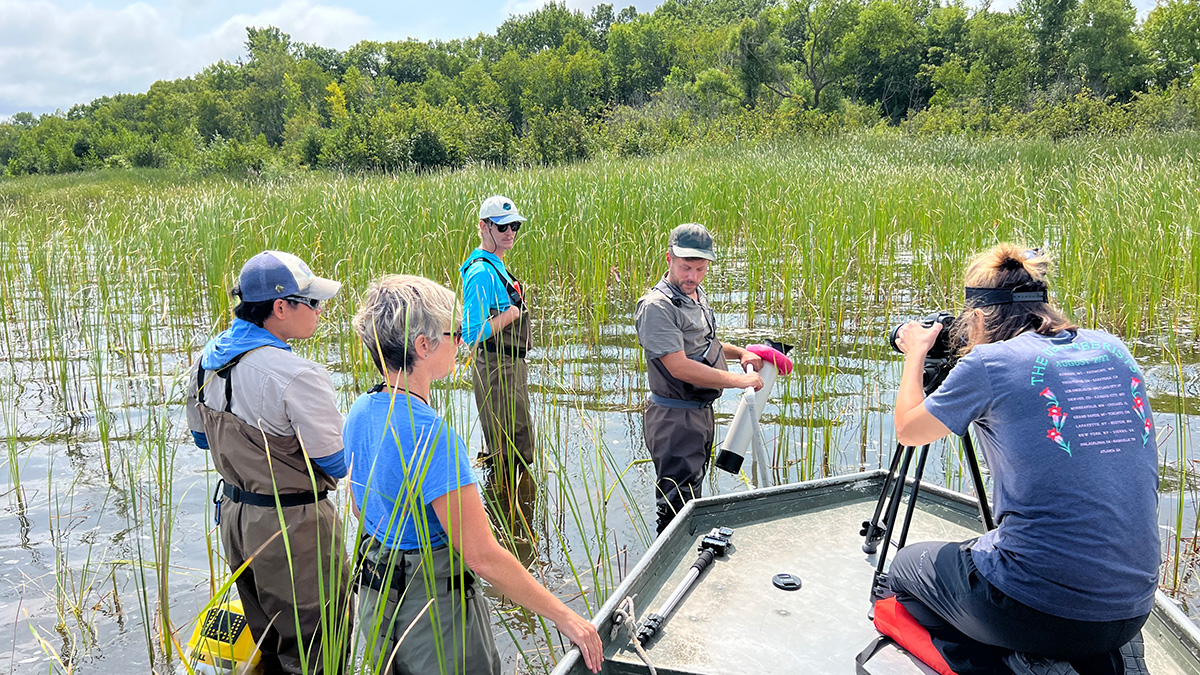
2023
- August 2023: Amy Schrank, project manager of Minnesota Sea Grant’s Invasive Cattail-Dominated Shorelines project delivered the presentation “Can Mechanical Removal of Invasive Cattails Benefit Fish Communities in Inland Lakes?” at the 153rd Annual Meeting of the American Fisheries Society in Grand Rapids, Michigan.
- August 2023: Amy Schrank, project manager of Minnesota Sea Grant’s Invasive Cattail-Dominated Shorelines project presented the webinar “Cattails: Friend or Foe” as part of the Minnesota Department of Natural Resources Minnesota Outdoor Skills and Stewardship Series.
- Summer 2023: The Invasive Cattail-Dominated Shorelines project team is finalizing data analysis and writing final project reports and manuscripts resulting from our research.
- June 2023: Amy Schrank, project manager of Minnesota Sea Grant’s Invasive Cattail-Dominated Shorelines project delivered the webinar presentation “Are Cattails Taking Over Your Lake?” as a part of Itasca Waters’ Practical Water Wisdom: A Virtual Learning Series.
- May 2023: Amy Schrank, project manager of Minnesota Sea Grant’s Invasive Cattail-Dominated Shorelines project provided an in-person project update to members of the Coon Lake Association at their annual meeting.
- Spring 2023: The Invasive Cattail-Dominated Shorelines project team continues to analyze data from the 2021 and 2022 field seasons. The project team is also planning for a scientific publication, a report about the findings from this project that can be shared with the public, and some final presentations.
2022
- November 2022: Watch "Enhancing Habitat and Diversity in Cattail-Dominated Shorelines" by the Minnesota Aquatic Invasive Species Research Center to learn more about Minnesota Sea Grant’s Invasive Cattail-Dominated Shorelines project.
- Summer 2022: The Invasive Cattail-Dominated Shorelines project team completed field sampling. Many of the project sites had low water levels from the previous year’s historic drought, which resulted in cattail regrowth. In other locations cattail removal was maintained because the cut cattail stems remained submerged.
- Spring and early summer sampling in Rainy Lake and Lake Kabetogama were delayed until July 2022 due to record flooding.
- Despite the drastic fluctuations in water levels and lake site conditions, the team was able to successfully collect fishes and sample plants and water quality at all nine project sites.
- Summer 2022: The Invasive Cattail-Dominated Shorelines project team hosted two in-person events at some of the project sites to explain why the restoration of native plant communities is important in Minnesota lakes.
- The first event was hosted at Long Lake in Becker County, Minnesota, and the second at Big Marine Lake in Washington County, Minnesota.
- The project team also presented at the Coon Lake Property Owners Association meeting, the Whitefish Area Property Owners Association, the Rainy Lake Property Owners Association annual meeting, and the Minnesota Aquatic Invasive Species Research Center’s Aquatic Invasive Species Research and Management Showcase.
2021
- Fall/winter 2021: Cattail removals were completed.
- Fall/winter 2021: The Invasive Cattail-Dominated Shorelines project team spent time analyzing data and presenting their preliminary findings at a number of venues including the Minnesota Aquatic Invasive Species Research Center's Aquatic Invasive Species Webinar series and the Minnesota Chapter of the American Fisheries Society annual meeting.
- Fall 2021: With the help of Kristen Loobek from the Minnesota Aquatic Invasive Species Research Center, the Invasive Cattail-Dominated Shorelines project team developed a postcard to hand out to folks interested in learning about Minnesota Sea Grant's Invasive Cattail-Dominated Shorelines project.
+
Why Minnesota Sea Grant?
This project supports Sea Grant’s mission to enhance the practical use and conservation of coastal, marine, and Great Lakes resources in order to create a sustainable economy and environment.
The project is expected to fill a critical information gap by contributing to an understanding of the effects of cattail removal on littoral zone (nearshore lake zone) plant and fish communities in Minnesota's inland lakes and account for the possibility of regional differences in these effects. The study will provide ecological data on current (2021) cattail management strategies. It will also inform resource managers about the benefits and costs of localized cattail removal on Minnesota lakeshores.
+
What have we done lately?
- October 2023: The Invasive Cattail-Dominated Shorelines project team visited Big Marine Lake in Washington County to conduct drone flights for aerial photography. The project team marked the locations of both invasive cattails and native bulrush to help determine if aerial photography and satellite imagery can be used to remotely sense invasive cattails.
- October 2023: The Invasive Cattail-Dominated Shorelines project team visited Ham Lake in Anoka County to scout new sites for the project.
- September 2023: Minnesota Sea Grant began hosting MNSG Extension Program Intern Jane Slentz-Kesler, a senior at Macalester College, who is working on the Invasive Cattail-Dominated Shorelines project. Jane is working to figure out if satellite imagery can be used to determine the extent of invasive cattails on Minnesota lakes over time.
- September 2023: Amy Schrank, Minnesota Sea Grant's Invasive Cattail-Dominated Shorelines project lead delivered the presentation "Can Mechanical Removal of Invasive Cattail Benefit Fish Communities in Inland Lakes?" at the Minnesota Aquatic Invasive Species Research Center (MAISRC) 2023 AIS Research and Management Showcase.
+
Participants & audience
The target audiences for this project include researchers and managers throughout North America who work with cattail and landowners whose recreation and lakeshore views are inhibited by dense cattail growth.
The project team includes:
- Amy Schrank, project manager, assistant extension professor, Minnesota Sea Grant Fisheries and Aquaculture Extension Educator, University of Minnesota.
- Daniel Larkin, project co-manager, assistant professor, Department of Fisheries, Wildlife, and Conservation Biology, University of Minnesota.
- Brendan Nee, project team member, master's student, Department of Fisheries, Wildlife, and Conservation Biology, Diversity Scholar and Dobie Fellow, University of Minnesota.
- Michael Tuma, project team member, master's student, Department of Fisheries, Wildlife, and Conservation Biology, University of Minnesota.
- Kailyn Schmitt, project team member, undergraduate student, Swenson College of Science and Engineering, University of Minnesota Duluth.
- Dylan Dahn, project team member, undergraduate student, Swenson College of Science and Engineering, University of Minnesota Duluth.
Project collaborators and participants include:
- Minnesota Department of Natural Resources, Aquatic Plant Management staff, will be helping the project team select lakes with encroached cattail stands in each of the state's three ecoregions (northern lakes and forests, north central hardwood forests, and western corn belt).
- Voyageurs National Park. Voyageurs staff are providing logistical support and helping with cattail removal for project sites located within Voyageurs National Park.
+
Funding
Funding for this project was provided by the Minnesota Environment and Natural Resources Trust Fund, as recommended by the Minnesota Aquatic Invasive Species Research Center (MAISRC) and the Legislative-Citizen Commission on Minnesota Resources (LCCMR).
Upcoming Events
Program Staff
Program News
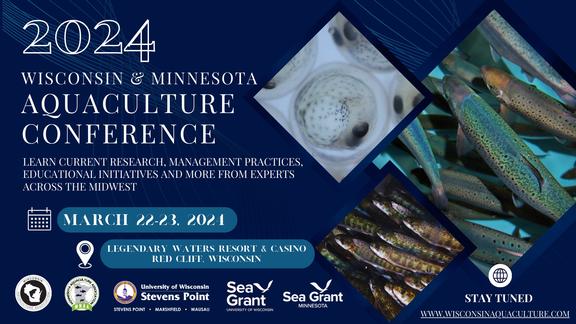

Staff from Minnesota Sea Grant Fisheries and Aquaculture Program will be presenting recent and ongoing projects that addres

Minnesota Sea Grant is hiring! Position opened January 26, 2024. Reviews will begin in mid-February and the position will remain open until filled.
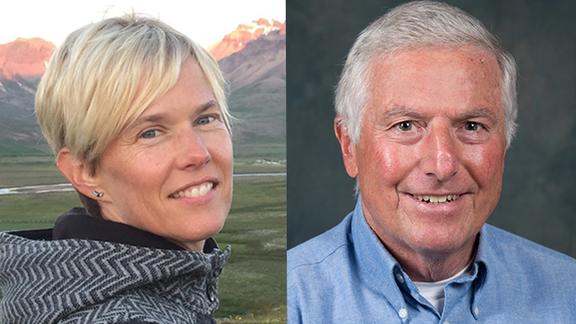
Minnesota Sea Grant extension educators will be presenting at the 153rd Annual Meeting of the American Fisheries Society, August 20-24, 2023, i
Featured Stories
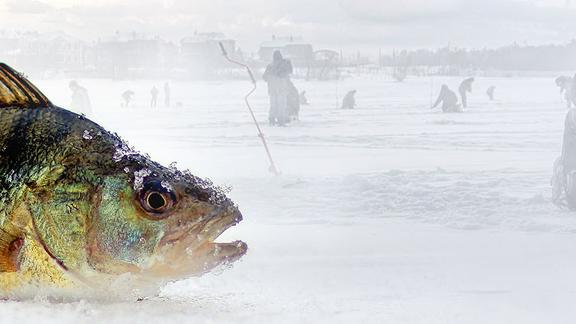
Our three-part March Extension Column highlights Minnesota Sea Grant's annual fisheries and aquaculture student award, project presentations and updates.
Image credit: ©kremldepall - stock.adobe.com
Media Mentions
- Pelican Lakes Association meeting set June 29 Pine and Lakes Echo Journal
- Northwoods Experience: Dozens Attend 8th Annual AIS Roundtable in Crosslake Lakeland PBS
- Minnesota Sea Grant Co-Hosts Great Lakes Fish Farm Session Morning AgClips
- Casting for Catfish, MAX Multi-Species Fishing Derby coming up on Outdoors Cale… Grand Forks Herald
- News release: Fish and Wildlife Almanac, Aug. 7 Minnesota Department of Natural Resources
- Drayton catfish tourney, Coon 'n Crockett Muzzleloaders match coming up on Outd… Grand Forks Herald
- Itasca Waters — Maintaining Quality of Place The Pilot-Independent
- Water Wisdom - Virtual Learning Series Aitkin Independent Age
- Amy Schrank to Present 'Are Invasive Cattails Taking Over Your Lake?' Yahoo News
- Amy Schrank to Present 'Are Invasive Cattails Taking Over Your Lake?' The Bemidji Pioneer


